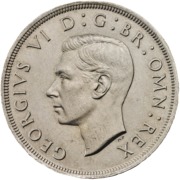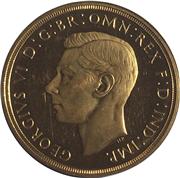 The 1937 Crown - George VI
The 1937 Crown - George VISilver (50%) 1937 crown from the Coronation year of King George VI.
Obverse designer Humphrey Paget had already completed the design for Edward VIII but due the abdication his coins were never seen by the public. To make matters worse, Paget was given just one month to complete the portrait of George VI. He did so with triumph and the new King's head proved to be a classic design.
As is common in the coronation year, Proof versions were also issued and in addition there was a frosted 'VIP' proof together with a very rare Matt Proof coin.
Diameter is 38.61mm and weight is 28g. SCBC 4078.
 The Reverse shows an ornately designed crowned coat-of-arms. The word CROWN appears below with the date 1937.
The Reverse shows an ornately designed crowned coat-of-arms. The word CROWN appears below with the date 1937.Coin shown is graded as VF.
Image credit: The Royal Mint.
Mintage: 418,700 (may include coins in sets)
Minted at The Royal Mint
More information (monarch, year, mint, country, category) can be found below coin listings.
Below are some coins currently being offered on eBay. As an eBay Partner, We may be compensated if you make a purchase.
List items on:
List items on:
Remember 1937 ?
In the UK: The monarch was George VI, who had his Coronation on 12th May. UK Prime Minister was Stanley Baldwin but after retiring was replaced with Neville Chamberlin. Frank Whittle tests the first jet engine. The 12-sided threepenny bit was introduced. The abdicated Edward VIII is given the title of the Duke of Winsor and marries Wallis Simpson. The Dandy comic is first published. JRR Tolkien's The Hobbit is published.
In the USA: President is Franklin D. Roosevelt (D-New York). The German airship Hindenburg explodes into flames when mooring to a mast in Lakehurst, New Jersey. Amelia Earhart with navigator Fred Noonan disappear after taking off from New Guinea. New York Yankees defeat New York Giants 4-1, to win their 6th World Series Title. The first feature-length animated cartoon with sound, Walt Disney's Snow White and the Seven Dwarfs opens and is a big hit. Napoleon Hill publishes Think and Grow Rich. The Lincoln Tunnel opens, connecting New York City to New Jersey.
In the USA: President is Franklin D. Roosevelt (D-New York). The German airship Hindenburg explodes into flames when mooring to a mast in Lakehurst, New Jersey. Amelia Earhart with navigator Fred Noonan disappear after taking off from New Guinea. New York Yankees defeat New York Giants 4-1, to win their 6th World Series Title. The first feature-length animated cartoon with sound, Walt Disney's Snow White and the Seven Dwarfs opens and is a big hit. Napoleon Hill publishes Think and Grow Rich. The Lincoln Tunnel opens, connecting New York City to New Jersey.
George VI (1936-1952)
 George VI was King of the United Kingdom and the British Commonwealth from 11 December 1936 until his death on 6 February 1952. He was the last Emperor of India and the first Head of the Commonwealth. His parents were George V and Mary of Teck.
George VI was King of the United Kingdom and the British Commonwealth from 11 December 1936 until his death on 6 February 1952. He was the last Emperor of India and the first Head of the Commonwealth. His parents were George V and Mary of Teck. George did not think he would be King, but took the throne after the abdication of his brother Edward VIII. George VI married Elizabeth (known as the Queen Mother) and the couple were very popular during the war years. George was a heavy smoker and died in 1952 from lung cancer. His wife became knows as "Queen Elizabeth the Queen Mother" and lived until 30th March 2002 when she was 101.
George VI is the father of Queen Elizabeth II.
Category: Crowns
The Crown is a very old coin, with origins dating back to Henry VIII. The English Crown first appeared in 1526. It was made of 22 carat gold ("crown gold") and has a value of five shillings (a quarter of a pound).By 1551, silver was being used to produce crowns, although gold was sometimes still used. The silver crown was quite large, being about 38mm and weighing about one ounce. Around that time many Europeans countries had similar sized silver coins which made them good for international trade as they were essentially interchangeable.
The metal used was 92.5% silver and the rest copper so as to make the coin harder. This hardness, together with a milled edge, made 'clipping' (which was cutting slices off the edge to steal some free silver) more difficult.
After the Union of England and Scotland in 1707 a new coin, the British Crown, replaced the English Crown and Scottish Dollar. The value was set at 5 shillings and the size was 38mm in diameter and weighed about 1oz as before.
Now more of a commemorative coin
Although the coin was always part of the British coin family, its large size made it unpopular for general circulation and the half-crown was favoured as the de-facto largest coin in circulation. The Crown was more-or-less relegated to a commemorative coin.
The British economy, especially after the World Wars, took its toll on the crown too. From 1816-1919 the crown was 0.925 silver, this was reduced to 0.500 silver in 1920 and in 1947 the Crown became Cupronickel (75% copper, 25% nickel). The size standardised at 38.61 mm and (silver crown) weight of 28.276g (1 oz).
Although not in current circulation, the Crown is still legal tender. After decimalisation in 1971 the Crown was officially valued at 25 pence. In the Eighties we had inflation which brought in higher denomination coins like the pound coin and the two-pound coin, so the Government decided that the crown needed to be restored to it former glory as biggest denomination coin and the crown was re-denominated to £5 in 1990.
Today the Crown is once again made in silver and gold, usually to satisfy collectors and investors. There is a little confusion with this as there are Gold Crowns which are worth £5 but there is another five-pound Gold coin from the sovereign family - see the article on Gold £5 Coin or Gold Crown?
Which Mint: The Royal Mint
The Royal Mint is the designated place for the UK to mint coins. It dates back well over 1000 years and is a Government-owned company. Formed in the reign of Alfred the Great about the year 886, during the period 1279-1812 it was generally referred to as The Tower Mint as it was housed at the Tower of London. The Master of The Royal Mint has included famous figures such as Sir Isaac Newton.
Since 2010 it has operated as Royal Mint Ltd, a company owned by HM Treasury, under an exclusive contract to supply all coinage for the UK although it also produces medals and coins for other countries. It is currently located at Llantrisant, Wales.
Country of Origin: United Kingdom
The United Kingdom (UK) is the Union of England, Scotland, Wales and Northern Ireland. It is often refered to as Great Britain (GBR). It has a long, rich history. The orignal coinage was Pounds, Shillings and Pence but since decimalisation on 15 February 1971, it is £1 = 100p, that is One Pound = 100 pence. The coinage of the UK is also a long history, the Royal Mint being established as long ago as 886AD when coins were hammered. Today there is perhaps 30 billion coins in circulation, and many (numismatic) collectors coins and sets are issued frequently in gold, silver and other metals.








